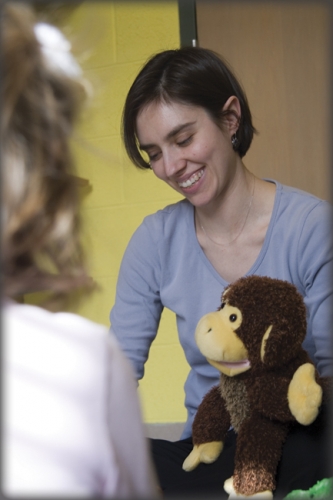Children don’t have to be taught language, Misha Becker says. At some point, they simply start speaking the way people around them speak.
“They’re natural language sponges,” says Becker, a child linguistics expert. “During the first two years of life, all they do is eat, sleep, poop, and learn language.”
But while linguists know that language-learning is easiest for children, they’re still trying to explain how kids work through the rules of semantics and syntax to form sentences that make sense — years before kids even learn that such rules exist. Anyone who’s taken basic grammar lessons has had “subject-verb-predicate” drilled into their heads, but three-year-olds know nothing of this sort.
“One of the fundamental puzzles of language-learning is how people trying to learn a language are able to map a string of words into correct structures, even if they don’t know what those structures are,” Becker says.
Becker worked on a small part of this puzzle by explaining the process children subconsciously use to distinguish between two classes of verbs.
Control verbs are enacted by the subject that precedes them. An example is “want” in “John wants to eat a sandwich.” John is the wanter; he is doing the wanting. Verbs such as “claim,” “beg,” and “decide” can also belong to this class of verbs, as long as they come right after the subject. Raising verbs, on the other hand, are not acted out by the subjects preceding them. In “Mary tends to wash the dishes,” for instance, Mary is not doing any “tending;” it doesn’t make sense to call her the “tender.” Other verbs that belong to this class include “seem,” as in “John seems to like Mary.”
Becker says that beginning at age five, children correctly classify any new verbs they hear as either control or raising verbs. They subconsciously use two cues: whether the subject in the sentence is alive, and whether the predicate of the sentence is an event or just a state of being.
“The more animate the subject is, like if it’s ‘John’ or ‘the teacher’ instead of ‘the table’ or ‘that rock,’ the more likely children will classify the verb after them as a control verb,” Becker says. “Another cue for control verbs is when the predicate is an actual event like ‘run a mile’ instead of a state of being, like ‘to believe.’”
The ability to correctly classify verbs enables children to use them properly in their own sentences, Becker says.
Becker’s study included forty-nine children ages three to five years old. She read the children sentences such as, “The door is trying to be purple,” and asked them if it was an “okay” sentence. Children who said “yes” had interpreted the verb “try” as a raising verb, while children who said “no” had interpreted it as a control verb.
Becker conducted a follow-up experiment that ruled out the possibility that the kids considered “door” a living thing. Still, only five-year-olds were able to correctly interpret verbs in most of the sentences.
“Somewhere along the way, around the age of five, children are beginning to reject incorrect sentences of this type,” Becker says. “They’re learning the structure of the language.”
Margarita De Pano was formerly a student contributor to Endeavors.
Misha Becker is an assistant professor of linguistics in the College of Arts and Sciences. The results of her study, titled “There Began to Be a Learnability Puzzle,” were published in Linguistic Inquiry in 2006.


